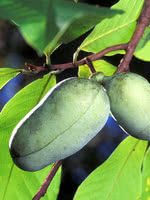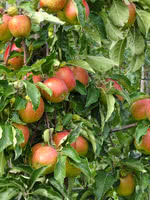Mon-Fri 9am - 5pm Mountain time
Pawpaw vs Fall Red Apple
Asimina triloba
Malus Fall Red
NOT AVAILABLE THIS SEASON - MIGHT RETURN
The Pawpaw tree produces delicious, sweet fruit with a unique banana-mango flavor. These oblong fruits start yellowish-green and mature to a dark brown in the fall. It is best to leave them on the tree until ripe, as they do not ripen well once picked. Pawpaws can be enjoyed fresh, in baking, or in ice cream.
Pawpaws produce the largest native fruit in North America. They typically grow as a small understory tree or large shrub on wooded slopes, in ravines, and along stream banks. They often spread through root suckers, forming dense thickets over time.
For fruit production to occur more than one genetically different Pawpaw tree is required. Our Pawpaw seedlings are grown from seed so they are all genetically different.
Note: Avoid eating the seeds and skin of the Pawpaw fruit as they can cause stomach pain for some individuals. Contact with the skin of the fruit can also result in skin irritation, so it is recommended to wear gloves during harvest. Plant this tree once. Due to its large tap root transplanting is not recommended.
The Fall Red Apple produces large ruby red apples with white flesh that are crisp and sweet. This delicious fruit is great for fresh eating or baking, with a good storage life. Its showy clusters of white flowers in spring add fragrance and beauty to your garden or yard.
Like most apples, the Fall Red apple will produce fruit on its own, but can benefit from another variety of apple (such as Prairie Sensation Apple) for cross pollination. It is a disease resistant alternative to the McIntosh Apple.

